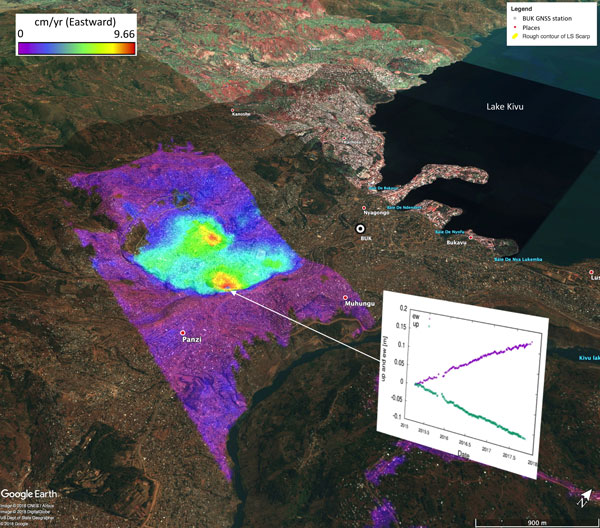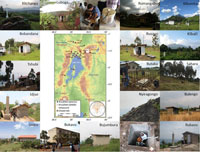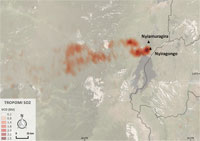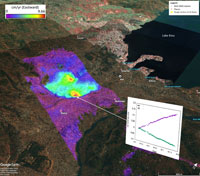Data from the Sentinel-1 and -5P satellites of the European Union's Copernicus programme are being used to better understand the mechanisms behind volcanic eruptions and landslides in Central Africa.
Funded by the Belgian Science Policy BELSPO (part of the STEREO programme), and the Luxembourg National Research Fund (FNR), the RESIST project contributes to understanding the source mechanisms that drive volcanic eruptions and landslides in the area extending from the North of Lake Tanganyika to the North of the Virunga Volcanic Province, in Central Africa.
The project is coordinated by the Royal Museum for Central Africa (RMCA), in collaboration with partners in the North: The National Museum of Natural History/European Center for Geodynamics and Seismology (NMNH/ECGS), Centre Spatial de Liège (CSL), Belgian institute for Space Aeronomy (BIRA), and NASA. The consortium is actively collaborating with partners from the South: the Goma Volcano Observatory (GVO), the Université Officielle de Bukavu (UOB), the Centre de Recherche en Sciences Naturelles de Lwiro (CRSN), the Rwanda Geology and Mines Board (RGMB), and the Université du Burundi (UB).
RESIST relies on ground-based instrument networks, field surveys and modern Earth observation techniques (MSBAS InSAR time-series, SO2 flux, rainfall measurements), to study and characterise the changes in monitored parameters that could/should be considered as significant in terms of volcanic and landslide processes. This is performed by: 1) filling the gap of knowledge on the ground-based level and 2) combining this information with innovative EO approaches.
The ground-based regional networks are made of 16 permanent Global Navigation Satellite System (GNSS) stations (Kivu-G-Net), 17 broadband seismic stations (Kivu-S-Net), four infrasound stations and one video camera at the summit of the Nyiragongo volcano, all telemetered in real time (see also www.virunga-volcanoes.org).
12 additional rain gauges complete the ground-based infrastructure and contribute to a broader network of weather stations from other initiatives. The monitoring stations and the telemetry were deployed by RMCA and ECGS and maintained with the help of local partners (GVO, CRSN, ICCN, RGMB, UB) in the frame of the RESIST and former projects
To study the volcanic activity of the Nyamulagira – Nyiragongo volcanoes and the associated ground deformations, ground-based observations are analysed together with space borne radar images acquired by several sensors. Radar interferometry (InSAR) allows detecting inflation/deflation movements related to underneath magma migration.
A fully automated tool was developed to handle the mass processing of all the possible InSAR pairs using CIS (CSL InSAR Suite). These interferograms are then used to produce time series of ground displacement in vertical and horizontal directions, using the Multidimensional Small BAseline Subset method (MSBAS).
The Nyiragongo is an open-vent volcano and is known for its lava lake – the world's largest – the fluctuations of which are studied as a proxy for the pressure changes in the magmatic system. Time series of radar amplitude images acquired by the Copernicus Sentinel-1 and COSMO-SkyMed satellites are also used to measure Nyiragongo lava lake-level variations, through casted shadow monitoring.
With the nearly operational Copernicus Sentinel-5P satellite, the InSAR/GNSS/seismic data will soon be processed and analysed in association with spaceborne measurements of the SO2 flux from the volcanic plume. With support to the training of local scientists, the teams involved would significantly contribute to the improvement of the study and monitoring capacity of most threatening geohazards that affect the region.
Landslides are another major hazard that affect these tropical regions. InSAR techniques are also applied to study landslides in the urban context of the city of Bukavu (DR Congo) where such slope instabilities are strongly affecting densely populated areas, with infrastructure damage and related consequences (for instance, water sanitation).
Ground observations and measurements (DGNSS, UAV, rainfall, etc.) are combined with InSAR time series, and spaceborne rainfall measurements from NASA–JAXA Tropical Rainfall Measuring Mission (TRMM) and Global Precipitation Measurement (GPM) data.
François Kervyn, RESIST coordinator and senior scientist at RMCA, says,"Sentinel-1 and -5P provide invaluable sources for quick, dense and reliable information. This is of prime importance for the monitoring of geohazards affecting such a highly threatened and densely populated region, which is also one of the most complex environments to work in."
About the Sentinels
The Sentinels are a fleet of dedicated EU-owned satellites, designed to deliver the wealth of data and imagery that are central to Europe's Copernicus environmental programme.
In partnership with EU Member States, the European Commission leads and coordinates this programme, to improve the management of the environment, safeguarding lives every day. ESA is in charge of the space component, responsible for developing the family of Copernicus Sentinel satellites and ensuring the flow of data for the Copernicus services, while the operations of the Sentinels have been entrusted to ESA and EUMETSAT.



